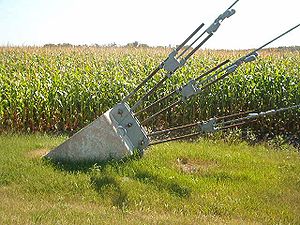UTPA STEM/CBI Courses/Statics/Force Equilibrium
Course Title: Statics
Lecture Topic: Force Equilibrium
Instructor: Dr. Seokyoung Ahn
Institution: The University of Texas-Pan American
Backwards Design
[edit | edit source]Course Objectives
- Primary Objectives- By the next class period students will be able to:
- Understand force equilibrium in three dimensions
- Sub Objectives- The objectives will require that students be able to:
- Understand and able to draw a Free Body Diagram for three dimensional structure
- Understand the concept of moment of inertia
- Develop a solution based on engineering analysis
- Difficulties- Students may have difficulty:
- Students will encounter problems understanding Free Body Diagram
- Students will encounter problems understanding physical meaning of "moment of inertia"


- Real-World Contexts- There are many ways that students can use this material in the real-world, such as:
- Radio masts and towers are, typically, tall structures designed to support antennas (also known as aerials in the UK) for telecommunications and broadcasting, including television. They are among the tallest man-made structures. Similar structures include electricity pylons and towers for wind turbines. The Warsaw Radio Mast was the world's tallest supported structure on land, but it collapsed in 1991, leaving the KVLY/KTHI-TV mast as the tallest.
- Read this story
- Radio mast



Model of Knowledge
- Concept Map
- Understanding structural uniqueness of radio mast
- Understanding the need of guy wires and pretension on guy wires
- Content Priorities
- Enduring Understanding
- Understand how step-functions work
- Important to Do and Know
- Understand the correlation between various classes
- Formulate ideas based on knowledge previously obtained
- Worth Being Familiar with
- Differential Equations
- Thermodynamics
- Heat Transfer
- Enduring Understanding
Assessment of Learning
- Formative Assessment
- In Class (groups)
- Generate equation to solve for thermometer output
- Homework (individual)
- Pre-lecture quiz after student has read chapter
- In Class (groups)
- Summative Assessment
- In class quiz over lesson
Legacy Cycle
[edit | edit source]Students will be asked to read chapter 3 of their measurements book prior to this lesson. They will also be provided with a temperature measurement quiz online so that they may evaluate their own understanding of the topic prior to attending class.
OBJECTIVE
By the next class period, students will be able to:
- Differentiate between zero-, first-, and second-order systems
- Understand first-order step functions
- Derive a time constant
The objectives will require that students be able to:
- Understand several heat transfer/thermodynamics equations
- Solve a differential equation
THE CHALLENGE
The students will be presented with the following questions:
- Why is it that when taking ones temperature with a glass mercury thermometer it is recommended that the thermometer stay in the mouth for at least three minutes?
- Is three minutes a sufficient amount of time?
- Can this time be reduced while maintaining accuracy in measurement?
GENERATE IDEAS
The students will be given a few minutes to individually write down their answers to the questions that have been presented. Students may respond with answers such as:
- It takes the thermometer time to reach steady state
- Because of the the reaction time of the thermometer
- Because of the thermometer's time constant, you want an accurate reading
MULTIPLE PERSPECTIVES
The following link presents application of trusses and frames in the construction industry: Walkway link 1 Walkway link 2
The professor will lecture on first-order step functions so that students will gain a better understanding of the topic. Students will be asked, "What do we need to know in order to answer our challenge questions?" and given a few minutes to individually write down their responses. Examples include:
- We need to know the materials of the thermometer and their properties
- We need to know some heat transfer, thermodynamics, and differential equation
RESEARCH & REVISE
Students will be provided with heat transfer and thermodynamics equations. They will then form groups and be asked to begin deriving the time constant.
TEST YOUR METTLE
Students will receive feedback on their progress and ideas as well as the correct process for deriving the desired equation. Students will be presented with a quiz at the beginning of the following class.
GO PUBLIC
Students will now be able to answer the questions presented at the beginning of the lesson and will be asked to turn in a brief explanation.
Pre-Lesson Quiz
[edit | edit source]Read the user testing data and then indicate whether it is quantitative or qualitative by selecting the appropriate radio button. When you are finished making your selection, click the "Submit" button.
Test Your Mettle Quiz
[edit | edit source]Read the user testing data and then indicate whether its severity by selecting the appropriate radio button. For the purposes of this exercise, you have already confirmed each item's veracity. When you are finished making your selection, click the "Submit" button.
Knowledge Check 3
[edit | edit source]In the previous lesson, Conducting User Testing, you conducted your own user test on an e-learning page from Wikiversity. In this knowledge check, practice what you know about analyzing results by judging the severity of each your findings. If you believe that the item needs resolution, think about how you might go about fixing it.
| Previous | Next |
Click Next to conclude this module.
Back to Topic: Instructional Design > User Testing of E-Learning Courses > Analyzing the Results
Images
[edit | edit source]-
KVLY tower from a distance of about one mile (1.6 km)
-
A guy-wire anchor


